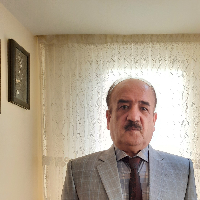Comparison of Pixel-based Algorithm (maximum liklihood) and Object-based Method (Support Vector Machine) in Classification of Land Use (Ahar-Varzeghan Area)
Author(s):
Article Type:
Research/Original Article (دارای رتبه معتبر)
Abstract:
Extended Abstract:
Introduction
In general, satellite data classification with digital interpretation method is separation of similar spectral sets and classification of images into groups or classes placed in each class, spectrum or a value (not being separable statistically). In other words, when a classification is carried out on data sets or images, in fact spectral classification is conducted and in the new image, every class or category is indicator of a specific phenomenon with a unit spectral value. The base for data classification is comparison of spectral value of picture pixels with the samples introduced by its interpreter or with initial classes and categories, constituted automatically in the time of digital interpretation. Hence, the pixels, values of which are not statistically significant, are placed in the same spectral group or class. So, preparation of land use maps by digital classification of remote data sensing depends on the methods used in classification, land coverage condition and environmental condition of the area. The aim of the present research study is to compare pixel-based classification algorithm (maximum likelihood) with object-based method (support vector machine) to prepare land use maps with the aid of SPOT5 satellite HDR image sensor and Landsat 8 satellite OLI image sensor in Ahar Chai basin from Ahar area to Varzegan. Methods and materials: In this research study a SPOT5 satellite HDR image sensor dated back to August 23, 2006 with four spectral bands and separation power of 10 m with path and passage 138-272, 138-273, 139-272 and 139-273 and Landsat 8 satellite OLI image sensor dated back to 2017/07/21 with route and passage 168-33, isolation power of 30m, increased to 15m through combination with band 8 were used to collected the necessary data. Topography map at scale 1/50000 and geological maps of 1/100000, land control data harvested by GPS, Garmin model and ArcGIS 10.4.1 and ENVI 5.3 software were used in this study. Information extraction from remote sensing data especially land cover can be obtained by digital classification. In practical some people are more comfortable using visual interpretation to retrieve land cover information. However, it is highly influenced by subjectivity and knowledge of interpreter, also takes time in the process. Digital classification can be done in several ways, depend on the defined mapping approach and assumptions on data distribution. The study compared several classifiers method for some data type at the same location. Maximum likelihood Classifiers (MLC) which use pixel-based and object-based classification using advanced supervised machine-learning algorithms such as Support Vector Machine (SVM).Therefore, the aim of the present research is to compare maximum likelihood in pixel-based processing and support vector machine algorithm in object-based processing in order to evaluate their performance in classification of LANDSAT 8 and SPOT 5 satellite images. The necessary pre-processing including geometrical corrections and atmosphere corrections were conducted on the image. Discussion and conclusion
Findings of the study indicated that both support vector machine algorithm in object-based classification and maximum likelihood in pixel-based classification enjoy higher and appropriate accuracy in classification and exploration of land use maps for Ahar-Varzegan area. However, considering the results obtained from the two algorithms used in this research, it can be concluded that support vector machine algorithm in object-based classification of satellite images provide the conditions for higher accuracy compared to maximum likelihood in pixel-based method. One of the main reasons of achieving higher accuracy in support vector machine algorithm classification is that in this algorithm, in addition to spectral data the data related to contexture, shape, position and content are also used in classification process, hence classification accuracy is increased significantly. After doing classification procedure using both algorithms of pixel and object-based method we proceeded on evaluation of the results reliability in them Conclusion
The results showed that, Findings obtained from both classification algorithms indicated higher accuracy of object-based classification with total accuracy of 94.99 % and Kappa coefficient for exploration of land use of Ahar-Varzegan area, this is while pixel-based classification with total accuracy of 89.39% and Kappa coefficient of 0.89% indicated acceptable level of classification. So that Feizizadeh et.al (2009) in exploration of East Azerbaijan land use with the aid of the two pixel-based and object-based algorithms concluded that object-based classification with total accuracy of 95.10 % has higher efficiency in exploration of the province land use compared to pixel-based classification with total accuracy of 88.37%.Keywords:
Language:
Persian
Published:
quantitative geomorphological researches, Volume:8 Issue: 1, 2019
Pages:
118 to 129
magiran.com/p2018419
دانلود و مطالعه متن این مقاله با یکی از روشهای زیر امکان پذیر است:
اشتراک شخصی
با عضویت و پرداخت آنلاین حق اشتراک یکساله به مبلغ 1,390,000ريال میتوانید 70 عنوان مطلب دانلود کنید!
اشتراک سازمانی
به کتابخانه دانشگاه یا محل کار خود پیشنهاد کنید تا اشتراک سازمانی این پایگاه را برای دسترسی نامحدود همه کاربران به متن مطالب تهیه نمایند!
توجه!
- حق عضویت دریافتی صرف حمایت از نشریات عضو و نگهداری، تکمیل و توسعه مگیران میشود.
- پرداخت حق اشتراک و دانلود مقالات اجازه بازنشر آن در سایر رسانههای چاپی و دیجیتال را به کاربر نمیدهد.
In order to view content subscription is required
Personal subscription
Subscribe magiran.com for 70 € euros via PayPal and download 70 articles during a year.
Organization subscription
Please contact us to subscribe your university or library for unlimited access!



